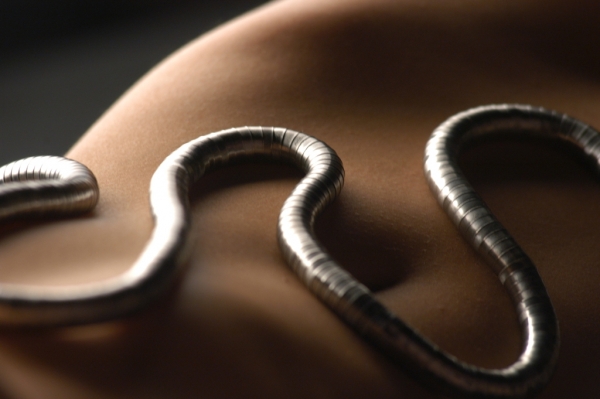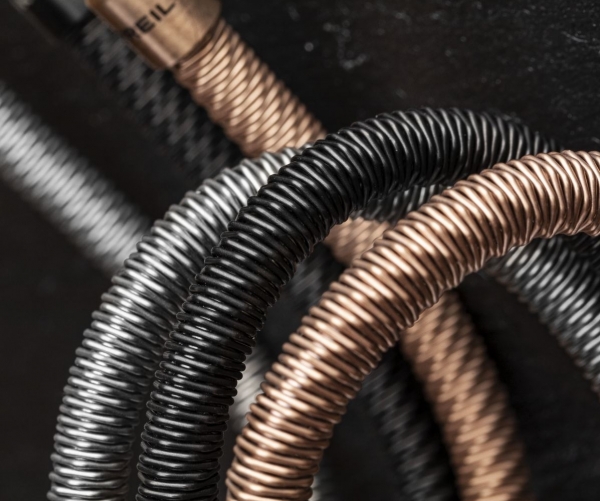Steel is a ferrous alloy, an industrial material with countless uses. Just to name a few, it is widely used in the production of small and large household appliances and for the construction of their components; in the building construction sector, where today more than ever steel finds vast modern and high-level architectural uses; in the mechanical and manufacturing industry; in the manufacture of containers for the preservation of foodstuffs or chemical products for its mechanical resistance – therefore long-lasting – and oxidation resistance; furthermore, many objects and medical equipment are made of stainless steel to guarantee the highest levels of hygiene..

Its use in the fashion and accessories industry is certainly more recent because, in spite of common thinking, its peculiar characteristics make it the perfect choice for the creation of small and elaborate objects, especially jewelry.
Steel does not always have the same composition: as it is an alloy, by changing the percentages of the elements it is made of, its intrinsic characteristics also change. In the case of jewelry, the steel used is the surgical steel, called 316L: a special alloy, so called because it is also used for the production of surgical instruments and prosthetic implants, very safe, not harmful to health and characterized by hardness and resistance to oxidation and corrosion.
Steel jewelry remains unaltered over time, unlike more noble materials such as gold and silver, need minimal maintenance because they are more resistant to scratches, bumps or chafing of everyday life, are hypoallergenic in almost all cases, do not darken or stain, have a cost suitable for all budgets, which makes them absolutely transverse.
In this context we often hear about Nickel free steel: it is important to specify that this element is absolutely present in steel which, being an alloy, has several components inside it.
Nickel is critical because it makes the alloy flexible, malleable and with the ability to absorb a shock without breaking. To be defined as Nickel free, the amount of Nickel released from a metal must not exceed 0.2ug/cm2/week in the case of jewelry that is in contact with the skin and 0.5ug/cm2/week in the case of jewelry that penetrates the skin (e.g. ear holes or piercings).
All Breil branded steel products comply with the Reach 1907/2006 Regulation: in fact, they are made with materials whose Nickel release is lower than the limits allowed by law and tested according to the EN1811:2011+ A1:2015+EN12472 method. That is to say that for each item produced is tested for compliance with the standard before it is marketed, after which sample checks are carried out through laboratory tests by the competent ATS. In this way, the safety of every single product sold is guaranteed.
Breil and the steel jewelry
The Breil brand was, to all intents and purposes, the first to introduce steel jewelry onto the market, convincingly arguing for the choice and, indeed, coming to create a real world of emotions around a material never before contemplated for a similar use. What’s more, he instilled a soul, gave it warmth and ennobled it through an original design, accompanied by innovative workmanship.
Coming to create steel jewelry was an almost natural step: Breil watches have always been characterized by a strong presence of the material, often enhanced by full shapes and important volumes.
Steel, thought to be cold and unchangeable, has become, through jewelry, a symbol of sensuality, fluid and soft, a true tactile emotion that is generated by the encounter with the skin of the wearer.

Steel processing
Working with steel can prove to be a fascinating and surprising adventure. Contrary to popular belief, its specific gravity is lower than that of gold and silver! It is perceived as a heavy material because in the most common uses it is attributable to large, bulky or full-shaped objects. This is because its cost allows for its wide consumption.
In jewelry, this characteristic allows the creation of jewels with original lines and designs, unthinkable if made of gold, silver or other precious materials. Being able to count on an enormous quantity of material makes it possible to experiment with various types of processing and create elements and components that are always different and original.
Steel, unlike gold and silver, is not a “soft” material: working it requires specific skills and uncommon expertise. The miracle takes place when this ability is associated with the fineness of the finishes typical of the goldsmith’s art: it is then that an object is generated, a jewel in this case, which turns out to be a true work of high jewelry.

Various steel finishes
The steel with which Breil jewelry is made is characterized by various finishes and treatments, which give each product different styles and imprints.
The most evident intervention is what is called IP, “ion plating”, which completely changes the classic silver color associated with steel, in a definitive and lasting way. The material is subjected to a “bombardment” of titanium ions that, combined with electric flows, assume different shades. This type of processing has found fertile ground in the world of fashion and accessories. The color yellow gold and pink gold are among the most popular, but Breil goes further: in fact, in the catalog you can find products offered in less usual color declinations, from blue to anthracite, from grey to green of the collection of watches New One.
Steel can also be worked on the surface thanks to increasingly effective and precise techniques, which have made it possible to increasingly characterize watches and, above all, jewelry, which by their very nature are more versatile. Here then that lights and shapes are enhanced through polishing, brushing and matting, which wisely carried out, make the products extremely fascinating.


